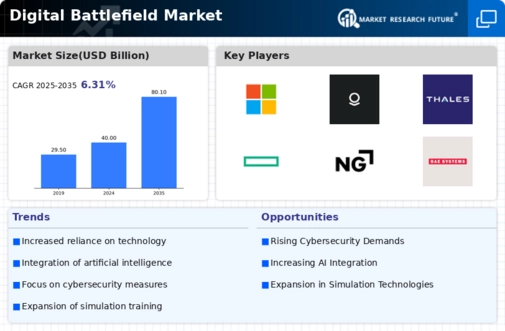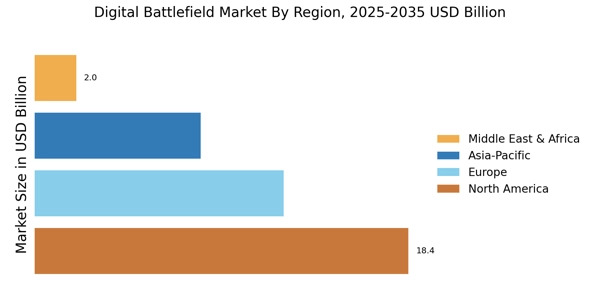Emphasis on Cybersecurity
As military operations increasingly rely on digital platforms, the Digital Battlefield Market faces heightened concerns regarding cybersecurity. The rise in cyber threats necessitates the development of robust cybersecurity measures to protect sensitive data and communication systems. In 2025, it is estimated that defense spending on cybersecurity will exceed 10 billion USD, reflecting the urgent need for secure digital infrastructures. This emphasis on cybersecurity not only safeguards military assets but also ensures the integrity of operations, thereby fostering trust in digital systems. Consequently, companies specializing in cybersecurity solutions are likely to see increased demand within the Digital Battlefield Market.
Increased Defense Budgets
The Digital Battlefield Market is benefiting from increased defense budgets across various nations. Governments are recognizing the necessity of modernizing their military capabilities to address evolving threats. In 2025, defense spending is anticipated to reach unprecedented levels, with many countries allocating substantial portions of their budgets to digital warfare technologies. This trend indicates a commitment to enhancing military readiness and operational effectiveness. As a result, companies involved in the development of digital battlefield solutions are likely to experience a surge in demand, positioning themselves favorably within the market.
Collaboration with Private Sector
The Digital Battlefield Market is increasingly characterized by collaboration between military organizations and the private sector. This partnership facilitates the rapid development and deployment of innovative technologies that enhance battlefield capabilities. By leveraging the expertise of private companies, military forces can access cutting-edge solutions that may not be available internally. In 2025, it is projected that such collaborations will lead to a significant increase in the adoption of commercial technologies within defense operations. This trend not only accelerates technological advancements but also fosters a more agile and responsive military environment.
Integration of Advanced Technologies
The Digital Battlefield Market is experiencing a notable shift towards the integration of advanced technologies such as artificial intelligence, machine learning, and big data analytics. These technologies enhance decision-making processes and operational efficiency on the battlefield. For instance, AI-driven systems can analyze vast amounts of data in real-time, providing military personnel with actionable insights. The market for AI in defense is projected to reach approximately 18 billion USD by 2025, indicating a robust growth trajectory. This integration not only streamlines operations but also improves situational awareness, thereby potentially reducing response times in critical scenarios.
Growth of Simulation and Training Technologies
The Digital Battlefield Market is witnessing a surge in the adoption of simulation and training technologies. These tools provide realistic training environments for military personnel, enhancing their preparedness for real-world scenarios. The market for military simulation and training is expected to grow significantly, with projections indicating a value of around 7 billion USD by 2025. This growth is driven by the need for cost-effective training solutions that can replicate complex battlefield conditions. By utilizing advanced simulation technologies, armed forces can improve tactical skills and decision-making capabilities, ultimately leading to more effective operations in the field.


















Leave a Comment